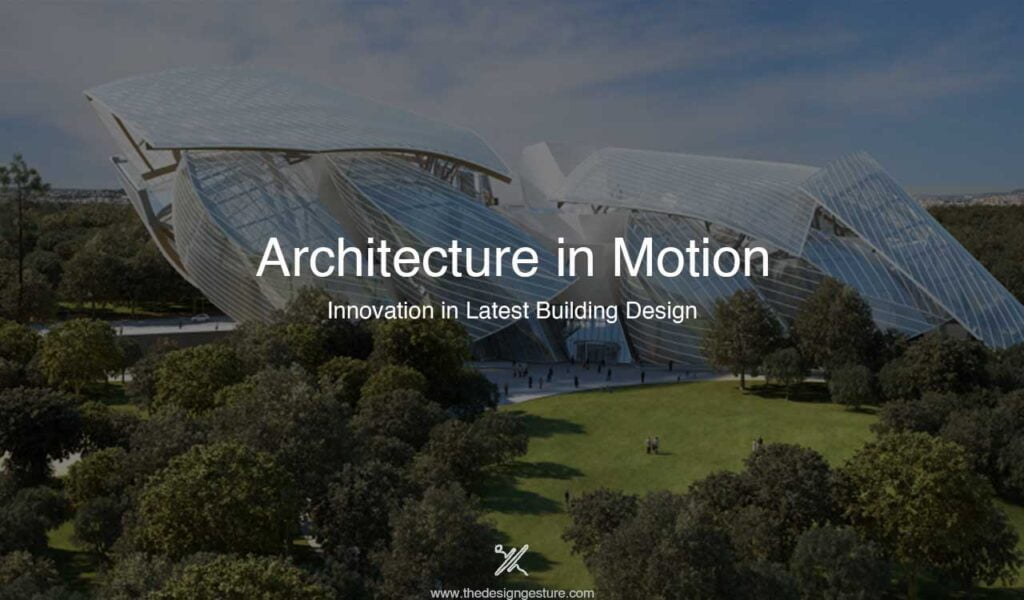Table of Contents
Introduction
Architecture in motion is one of the leading factors of contemporary ways of expression in architecture. It will examine different examples of architectural motion, then hypothesize one of the possible reasons for expressing movement. Motion in architecture is a new concept in modern architecture to make the structure more dynamic and sometimes can even be used as a sustainable energy source.
Motion in architecture can also be used to increase curiosity and creativity in the structure and attract people. Motion in architecture is a dynamic way for architects to portray their structures and challenge themselves to experiment with different forms.
History of Architecture in Motion
Movement in architecture through various documents deals with relationships between space, form, and observer. Movement in architecture goes as far back as ancient Rome, when people considered rotating architecture very auspicious and a symbol of prominence and a way to show off our wealth. The structures were generally applied with a certain movement, either by kinetic energy or manual energy. The movement or the orientation of the designs could respond to the positioning of the sun, wind flow, weather, or type of activities.
Ancient Roman Emperor Nero has been categorized by historians as one of the most dynamic and fascinating leaders in history, with his architecture reflecting his innovative personality. Nero ordered Roman architectural engineers Severus and Celer to build a glamourous palace named Domus Aurea, which is said to be one of the first few examples of architecture in motion that has been recorded. The revolving dining room design remains a creative example of engineering.
Various ways to apply architecture in motion
Revolving Restaurants
Revolving Restaurants are used to impress visitors, treat patients, and improve the green qualities of a structure by keeping rooms in or out of the sun. It is something different and provides a different view to the visitors of the restaurant.
Perlan, Reykjavik, Iceland
Perlan is a futuristic revolving glass-domed of fine dining restaurant in a park setting, with a cocktail bar located in Reykjavik, Iceland. Perlan: Wonders of Iceland, sits on top of the Oskjuhio hill, which is the highest hill in the city. It is an exhibition and an experience of a 360-degree view of Reykjavik and its surroundings from the observation deck and a viewing terrace.
Al Dawaar, Dubai
Al Dawaar is Dubai’s only rooftop, revolving restaurant. Watch 360-degree panoramic views of the city as you enjoy a lavish spread of international delicacies along with living kitchen dining. Revolving hotel restaurant offering stunning views and an international buffet in an elegant setting.
Om Revolving Restaurant, Jaipur, India
The city of Jaipur is colors, traditions and of course food, one of the famous restaurants there is the Om Revolving Restaurant. One of the many heritage attractions of the Pink City, such as the Hawa Mahal, the Nahargarh Fort, and the Jal Mahal, is visible from the hotel. This rotating hotel is on the 14th-floor serving North Indian and Rajasthani specialty dishes.
360 degrees restaurant, Pune, India
360 Degree at Bhosale-Shinde Arcade on JM Road is an innovative restaurant in the city. 360 Degree spreads across four floors, 7-10th floor, rotating at its core. It provides the customers with a different experience, giving a complete view of the Pune city skyline within 60 mins.
Dynamic Skyscrapers
Skyscrapers have been a very distinct part of modern architecture. But skyscrapers in recent years have become nothing but merely tall structures extending vertically. Skyscrapers needed change, advancement, and creativity as a part of their form. Movement in a skyscraper is not only a way to make them look exotic but considering their heights, movement in skyscrapers can also be used sustainably.
The Rotating Dubai Tower
Rotating Tower in Motion is a 68-floor with a height of 313 meters, the skyscraper was designed by architect David Fisher. In the Rotating tower, all the 59 moving floors move 6meters per minute around a central service spine while wind turbines play a fundamental role by capturing the breeze to provide clean, green energy. The building will feature a designated parking area on every floor, with the owners’ vehicles being raised and lowered as required by special elevators.
Mexico’s Twin Towers
Mexico celebrated 200 years of independence by building two skyscrapers shaped like an ellipse. The towers are designed by competition-winner architects, Vasquez and Wedeles Architects. Mexico’s Twin Towers mimic each other in shape and movement. One of the towers extends geometrically from a square at its foundation and is shaped by four extruding squares warped on their vertical axis, to a rectangular tower at the top. It is a way to express their heritage, the center of the building marks the direction of the sun.
Rotating Homes
Rotating structures have been employed to solve problems and create effects that stationary buildings can’t achieve. Rotating buildings offered ever-changing vistas and made interior spaces more flexible and adaptable.
Sunhouse 360
Sun House Andalusian company from Marbella, Spain, the contemporary Sunhouse 360-degrees, is a rotating farmhouse. The Sunhouse 360 house is equipped with a rotation system that allows it to turn endlessly around its axis for absorbing maximum solar energy. This way, it can help homeowners decrease 70 percent electricity costs compared to a traditional house. Emissions of carbon dioxide are also reduced by up to 68 percent.
Domespace: Rotating Dome Home
Rotating Dome Home was built by the French company Domespace, this 2,300-square-feet dome home is located on a wooden property in New Paltz, New York. Rotating Dome Home is a circular abode that spins a full 360° to offer gorgeous forest views at every possible angle. The rotation is so smooth and gradual as to be imperceptible from both inside and outside the house. The primary objective of the rotation is to make optimum use of the solar panels that line the roof of the Domespace and the passive solar properties of the house’s many windows.
Motion in Façade
The results of modeling and simulating the mechanics of the facade elements based on the sun position are the bases for the virtual motion as well as the reference. Interactive facades are dynamic in the translation of space in architecture, especially in the aspects of aesthetics, sustainability, adaptation to the environment, and data relay through the medium of light, motion, and embedded technology. The design of interactive facades is complicated, and it requires time and effort in the comprehension of the internal functions of the facade from the conceptual stage to occupancy.
The Hive, India
Hive is an intelligent, adaptable, and modern family home designed by Openideas Architects in the city of Surat in Gujarat, India. The modulating, ever-changing mechanical façade of the house was designed in synchronization with the conceptual form of the ‘honeycomb’. The opening and closing of the solar sensor-based facade lie at an exciting intersection of art and engineering.
The Bund Finance Center
The Bund Finance Center is a building in The Bund, Shanghai, China designed by Foster + Partners + Heatherwick Studio. The Bund Finance Center is prominent for its three, overlapping, turning layers of vertical stainless-steel pipes. These layers, inspired by theatre curtains, slowly rotate around the building. The building is circled by a moving curtain, which alters the changing use of the building and reveals the stage on the balcony and views.
Al-Bahar Towers
buildingAl-Bahar Towers is in the financial center of Abu Dhabi is designed by Aedas Architects and represents one of the most impressive examples of adaptive architecture and integrated design completed in recent contemporary architecture. The key design influences were to develop an energy-efficient and iconic building, drawn from the local vernacular Islamic architecture.
The most iconic element of all buildings is the movable shading, which wraps most of the envelope and modifies its shape, appearance, and performance. The glazed facade building in the region was the best possible approach, leading to a series of advantages such as enhanced daylighting within the building, reduced use of artificial lights, and associated energy savings.
Rotating roofs
The Devon House, Rotating rooftop house, Devon, UK
The rotating rooftop house is designed by D Haus, this two-story property in Devon was constructed with a rotating upper pavilion. The rotating rooftop house was inspired by the natural form of a bird in flight, the triangular-shaped pavilion offers access to a spacious outdoor terrace that contains a seating area and a beautifully landscaped rooftop garden. The rotating pavilion consists of the main bedroom and the living space which allows occupants to take advantage of panoramic views of the landscape.
Conclusion
Movement in architecture is an ancient concept that is slowly being applied to conventional structures, mainly to increase curiosity and ignite the sense of movement. The sense of movement belongs to one of the nine senses of the human body. Movement in architecture can give people a complete sensory experience. It can not only help the users of the building to view various external surroundings, but also the people outside the building to get a 360-degree view of the entire building without even moving an inch.
Movement in architecture is further being blended with creativity and technology to create sustainable structures. Motion in architecture can be combined with climate-responsive motion in façades, solar roofs, motion with kinetic energy and many more.
Motion in architecture could be the future of architecture or could be dismissed as pure folly. Motion in structures is fascinating, yet still needs to make an architectural impact with surprising relevance to issues in contemporary architectural design.
FAQs
Q. What is architecture in motion?
A. Architecture in motion refers to the concept of incorporating movement into architectural design. This can include physical movement, such as rotating or moving parts of a building, as well as the perception of movement created through design elements. Architect in motion architecture focuses more physical elements.
Q. How is motion used in architecture?
A. Motion in architecture can be used in various ways, such as rotating buildings, moving façade elements, or kinetic sculptures. It is often used to create dynamic and visually striking structures that interact with their environment. Latest Buildings were made by keeping movement architecture concept in mind.
Q. What are the benefits of incorporating motion into architecture?
A. Incorporating motion into architecture can have several benefits. It can make normal building a motion building by making it more dynamic and visually interesting, improve energy efficiency through passive design strategies, and create interactive experiences for users.
Q. How does motion architecture contribute to sustainable design?
A. Architecture of movement can contribute to sustainable design by incorporating features that respond to environmental conditions. For example, building in motion i.e., rotating buildings can adjust their orientation to maximize natural light and ventilation, reducing the need for artificial lighting and HVAC systems.
Q. What are some examples of motion architecture?
A. Examples of motion architecture include rotating buildings, moving façade elements, and kinetic sculptures. These structures often use innovative engineering and design techniques to achieve their dynamic effects. This can be explained in a better way by using motion diagram architecture.




